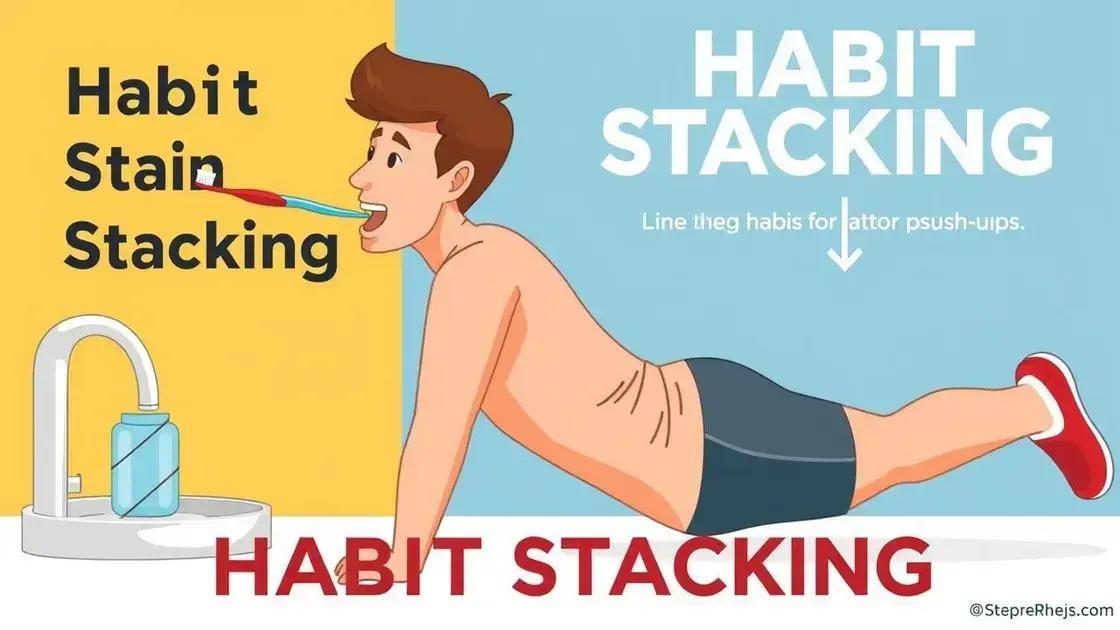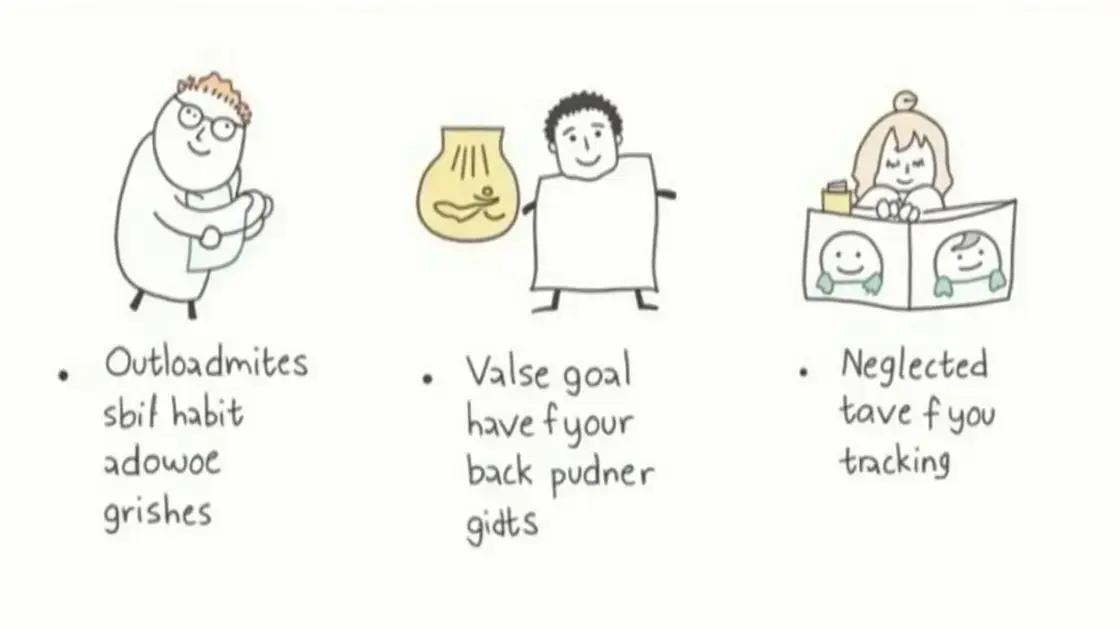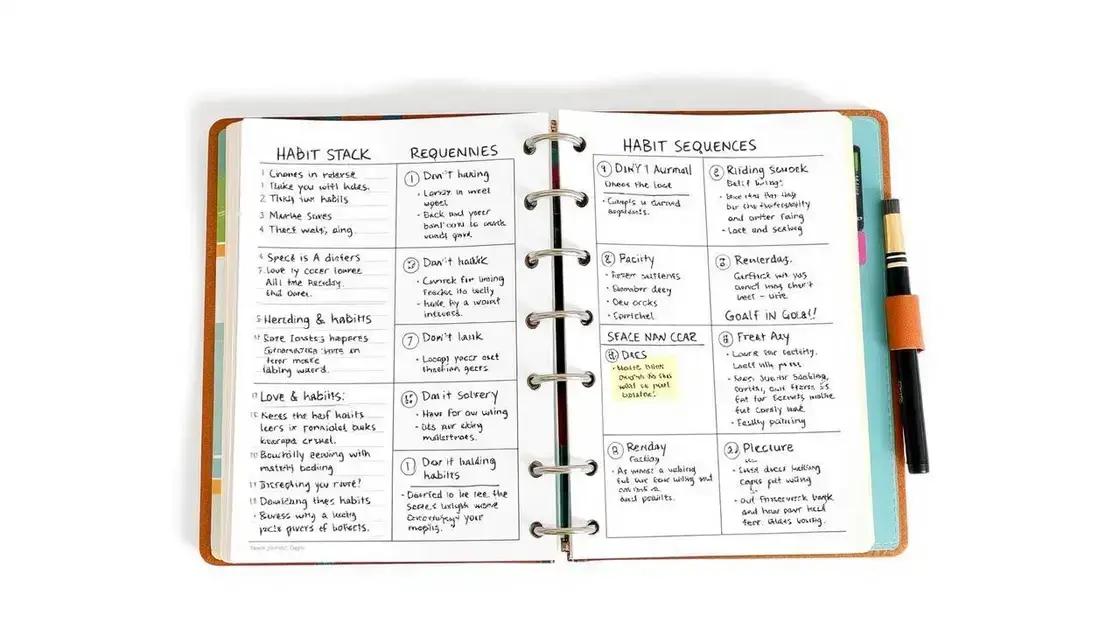Habit stacking is a powerful technique for building a healthy lifestyle by linking new habits to existing ones. To succeed, one should start small, choose specific habits, use triggers, track progress, and be flexible in adjusting the plan as needed.
Are you looking to build a healthier lifestyle? Habit stacking is a powerful technique that enables you to create lasting changes by linking new habits to existing ones. This article will guide you through understanding what habit stacking is, the best practices to maximize its effectiveness, common pitfalls to avoid, and how to create your personalized habit stacking plan. By the end, you’ll be well on your way to achieving your health goals with ease.
Understanding Habit Stacking

Understanding habit stacking is the first step towards creating a healthier lifestyle. It is a method that allows you to link new habits with existing ones, making it easier to incorporate positive changes into your daily routine. By stacking habits, you essentially create a chain reaction of productivity and wellness.
What is Habit Stacking?
Habit stacking involves taking a habit you already do and adding a new one to it. For example, if you want to start doing push-ups in the morning, you can stack this habit onto an existing habit like brushing your teeth. The idea is that by tying a new behavior to an already established habit, it’s easier to remember and practice.
How It Works
The key to habit stacking is the natural tendency of your brain to associate activities. When you perform a task regularly, your brain creates a neurological pathway that makes it easier to repeat that action. By adding new habits to these existing ones, you reinforce the behavior and increase the likelihood of success.
Benefits of Understanding Habit Stacking
One of the main benefits of this approach is that it simplifies the process of building new habits. Instead of overwhelming yourself with numerous changes at once, you can make gradual improvements to your daily routine. It also encourages consistency, as stacking makes each new habit feel more manageable.
Habit stacking is scalable; you can start with one or two new habits and gradually add more as your skills and confidence grow. This gradual approach helps in preventing burnout and increases your chances of maintaining a healthy lifestyle long-term.
Examples of Habit Stacking
Some simple examples of habit stacking include:
- If you want to drink more water, do it right after your morning coffee.
- After your daily walk, spend 5 minutes doing stretching exercises.
- Before you sit down to read a book, take a moment to meditate or practice breathing exercises.
By trying out these examples, you start to see how easily you can integrate new healthy habits into your life using habit stacking.
Best Practices for Habit Stacking

Implementing best practices for habit stacking can significantly enhance your journey towards a healthier lifestyle. Here are key strategies to follow:
1. Start Small
When creating your habit stack, begin with just one or two small habits. This reduces overwhelm and increases the chances of success. For instance, combine drinking a glass of water with your morning routine to start hydrating early.
2. Make It Specific
Be clear about what habits you are stacking. Instead of saying, “I will exercise,” specify, “I will do 10 push-ups right after I brush my teeth.” This clarity helps in execution and tracking progress.
3. Use Triggers
Identify clear triggers for your habit stack. A trigger is an existing habit or event that prompts you to start your new behavior. For example, after pouring your morning coffee, take 5 minutes to meditate.
4. Keep a Habit Tracker
Consider using a habit tracker to monitor your progress. This can be a simple checklist or a dedicated app. Seeing your successes can motivate you to continue stacking habits.
5. Be Patient
Building new habits takes time. If you miss a day or struggle, don’t get discouraged. Focus on consistency over perfection and keep persisting.
6. Review and Adjust
Periodically review your habit stack to see if it is working for you. If a habit isn’t sticking, try adjusting the trigger or associated habit. Flexibility is key to finding a system that works for you.
7. Celebrate Small Wins
Each time you successfully complete your habit stack, celebrate it! This reinforces your behavior through positive feelings, making you more likely to repeat it.
By following these best practices, you can create effective habit stacks that support your goal of building a healthy lifestyle while making the process enjoyable.
Common Mistakes to Avoid

When practicing habit stacking, it’s important to be aware of common mistakes that can hinder your progress. Here are some pitfalls to avoid:
1. Overloading Your Schedule
One common mistake is trying to stack too many habits at once. This can lead to feeling overwhelmed and discouraged. Start with one or two habits and gradually add more as you become comfortable.
2. Ignoring Your Existing Habits
Not considering your current habits can make habit stacking less effective. For successful stacking, link new habits to those you already do regularly. This ensures that the new behavior fits naturally into your routine.
3. Setting Vague Goals
Being too vague with your habits can lead to confusion and failure. Instead of “exercise more,” specify “do 15 minutes of yoga after my evening shower.” Clear goals help in maintaining focus.
4. Neglecting to Track Progress
Failing to track your habit stacking can make it harder to see progress. Keep a journal or use an app to monitor your habits. Regularly reviewing your progress keeps you motivated.
5. Not Being Flexible
Sticking rigidly to a habit stack can be counterproductive. Life changes and sometimes habits need to be adjusted or replaced. Don’t hesitate to reassess and modify your habits as needed for better success.
6. Ignoring the Importance of Triggers
Some people forget to use effective triggers for their new habits. A trigger is an event that reminds you to perform your new habit. Be sure to choose strong and reliable triggers that align with your existing habits.
7. Focusing Only on Results
Many make the mistake of only focusing on the end results. While it’s good to have goals, it’s essential to enjoy the process of building healthy habits. Celebrate your small wins to stay encouraged.
Avoiding these common mistakes will help you create a successful habit stacking system that leads to a healthier lifestyle.
Creating Your Habit Stacking Plan

Creating your habit stacking plan is vital for building a healthy lifestyle effectively. Follow these steps to develop an actionable plan:
1. Identify Your Goals
Start by determining what you want to achieve. Setting clear goals will guide your habit stacking. For instance, if your goal is to exercise more, you can select habits related to physical activity.
2. Choose Your Existing Habits
Look at your current daily routines and decide which habits you can build upon. Find reliable activities that you already complete consistently, such as brushing your teeth or having breakfast.
3. Pick New Habits to Stack
Select one or two new habits to add to your existing ones. Make sure they align with your goals and are realistic. For example, if you want to improve flexibility, consider pairing post-meal stretching with your dinner routine.
4. Create a Sequence
Outline the order in which your stacked habits will occur. A well-defined sequence helps you know exactly when to perform each habit. For example, “After I finish my coffee, I will meditate for 5 minutes.”
5. Set Reminders and Triggers
Establish clear reminders for your new habit stack. Use alarms, sticky notes, or apps to help you stay on track. Make your triggers noticeable and relevant to the habits you are stacking.
6. Track Your Progress
Keep track of your habits using a journal or an app. Documenting your success helps maintain your motivation and catch any deviations from your plan early.
7. Review and Adjust
Regularly assess your plan. If a habit isn’t fitting well, feel free to change or swap it out. Be flexible and fine-tune your habit stacking as needed for continued success.
By following these steps, you can create a personalized habit stacking plan that sets you on the path to a healthier lifestyle.
Embrace Habit Stacking for a Healthier Lifestyle
By understanding the concept of habit stacking, choosing effective practices, and avoiding common mistakes, you can effectively build a healthier lifestyle. Creating a personalized habit stacking plan allows you to integrate new, positive habits into your daily routine seamlessly.
As you start this journey, remember that progress takes time and patience. Track your successes, celebrate your achievements, and make adjustments as necessary to keep your momentum going. By embracing habit stacking, you empower yourself to create lasting changes in your life that contribute to overall well-being.
With persistence and dedication, you can build a healthier lifestyle step by step.
FAQ – Frequently Asked Questions about Habit Stacking
What is habit stacking?
Habit stacking is a technique where you link a new habit to an existing one to make it easier to adopt.
How can I create a habit stacking plan?
Start by identifying your goals, choosing existing habits, and selecting new ones to stack, following a sequence and setting reminders.
What are some common mistakes in habit stacking?
Common mistakes include overloading your schedule, being vague in your goals, and neglecting to track your progress.
How can I track my progress with habit stacking?
Use a journal or an app to monitor your habits and document your successes, which helps maintain motivation.
How do I choose which habits to stack?
Choose existing habits that are already part of your routine and select new habits that align with your health goals.
Is habit stacking suitable for everyone?
Yes, habit stacking can be tailored to fit anyone’s lifestyle, but it’s essential to start small and adjust as needed to match your pace.












